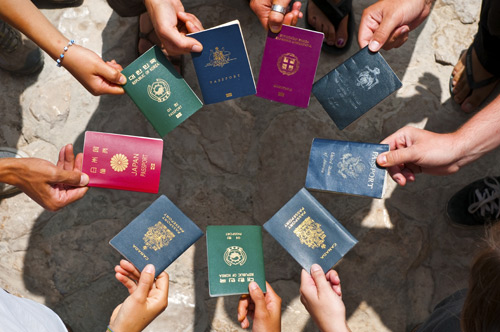
Around the world: how has immigration shaped the global physics community? (Courtesy: iStockphoto/Joel Carillet)
By Hamish Johnston
In December 1938 Enrico Fermi travelled to Stockholm, where he was presented with that year’s Nobel Prize for Physics for his insights into the atomic nucleus. But after the ceremony, Fermi did not return to his native Italy. Instead, he joined his wife and young children on a voyage to the US. Fermi went on to make major contributions to physics in that country – including playing crucial roles in developing nuclear weapons and nuclear energy.
Fermi is just one of many Nobel laureates who became immigrants, by which I mean he settled permanently in a country different to that in which he was born. He made the move in 1938 because his wife Laura was Jewish and Italy had just passed racial laws that restricted the civil rights of Jews. Another Nobel-prize-winning physicist to flee fascism was Albert Einstein, who moved to the US in 1933 after Germany passed similar laws.
And it wasn’t only established physicists who got caught up in this migration. Arno Penzias, who shared the 1978 prize for discovering the cosmic microwave background, was part of the Kindertransport that rescued thousands of Jewish children from Europe in 1938–1940. Penzias and his brother were taken from Germany to Britain, where they were reunited with their parents and then eventually ended up in the US. We are left to wonder whether physics in postwar Europe would have been much richer if these and other talented scientists had not been forced to leave.
Physicists change country for a variety of reasons. Einstein and Penzias fled persecution and possible death, whereas others, such as Marie Curie or Abdus Salam, moved to improve their career prospects. In the run-up to the 2015 physics Nobel – which will be awarded at 11:45 CEST on Tuesday 6 October – we will be looking at how Nobel-prize-winning physicists have been moving around the globe over the past century.
Tomorrow we will unveil a series of Physics World infographics that illustrates the patterns of migration. The story begins with Curie herself, who emigrated from Poland to France in her mid-20s, arriving as a “foreign student” in today’s parlance. Despite her stunning scientific achievements in France – she remains the only person to win Nobel prizes in both physics (1903) and chemistry (1911) – Curie was vilified by some parts of French society for being a foreigner. Xenophobia notwithstanding, she resisted persistent calls to return to Poland and has become one of the most well-known French scientists of all time.
The story ends, at least for now, with Shuji Nakamura, who shared last year’s prize for his development of blue light-emitting diodes. He left his native Japan in 1999 after doing his prize-winning research to join the University of California, Santa Barbara.
Check back tomorrow to explore our great new infographics, in which we reveal which countries have been the big winners when it comes to attracting top physicists. And you’ll also be able to find out which countries have lost the most talent, and why.
The immigration for different reasons of scientists involved in different disciplines is not something new. In fact, more than a thousand years back, the Bagdad’s “House of Wisdom” (dar-ul-hikmah) was perhaps the biggest ensemble ever of “scientists” from different cultures, disciplines and countries; their varied contribution proved to be the watershed for the different modern scientific disciplines.
Trackback: Physicists in motion: immigration and the Nobel prize – MyPhysNet